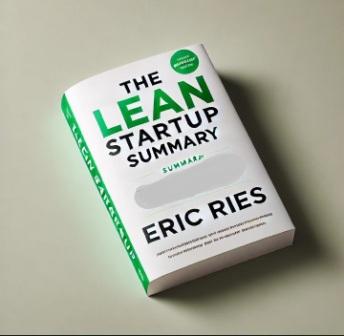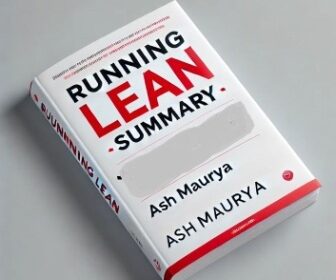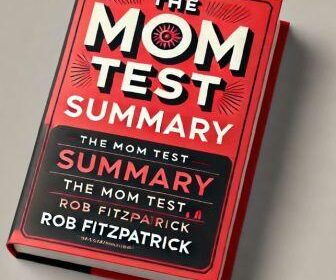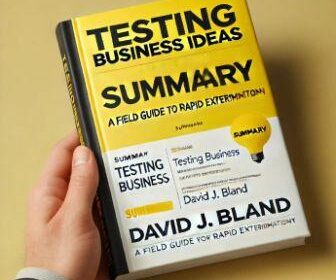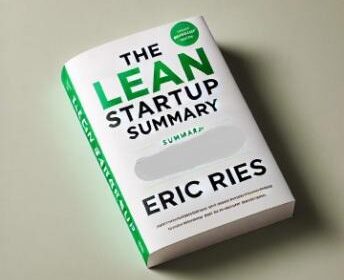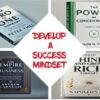Summary The Lean Startup by Eric Ries
"We must learn what customers really want, not what they say they want or what we think they should want."
Eric Ries Tweet
The Lean Startup Summary
Starting and running a business is hard. The “Lean Startup” makes it easier.
If you have been wondering when you will have the time to read “The Lean Startup”, we have put together the Lean Startup Summary to help you get the key ideas from the book in minutes.
We have only scratched the surface with this summary. Want more juicy details from the book?
Get the book here if you don’t have it already. You can also listen to the audiobook for free. Lets get started.
The Lean Startup
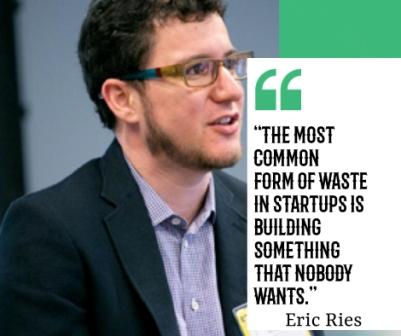
Introduction
The Lean Startup introduces key concepts such as the Minimum Viable Product (MVP), validated learning, and the Build-Measure-Learn feedback loop, all of which are fundamental to the Lean Startup methodology.
This book has had a profound influence on how startups and large companies approach product development and innovation and has led to a lot of business success.
Click on the tabs below to read the book summary
The Lean Startup teaches you how to build a new business or product by starting small and learning quickly.
Instead of spending lots of time and money making something perfect right away, you create a simple version first and see how people like it.
You then use their feedback to make it better step by step, which helps you avoid big mistakes and create something people really want.
The book is aimed at entrepreneurs, startup founders, product managers, and anyone involved in innovation or business development.
It is also valuable for leaders in larger organizations looking to foster a culture of continuous innovation.
“The Lean Startup” is a book that teaches people how to start and grow a new business in a smart way. Here’s a simple breakdown:
Introduction: Start
Imagine you have an idea for a new toy or game.
Instead of spending all your time and money making the perfect version right away, this book suggests starting small and testing your idea to see if kids really like it.
Chapter 1: Start
A startup is like a small, new business that’s trying to figure out what people want.
The book says it’s better to learn quickly what works and what doesn’t, rather than just guessing.
Chapter 2: Define
Before making the whole toy, you make a simple version of it (called a Minimum Viable Product, or MVP) to see if kids are interested.
This way, you don’t waste time making something no one wants.
Chapter 3: Learn
Once you have the simple version, you watch how kids play with it.
You learn from what they like and don’t like, and you can make the toy better based on what you discover.
Chapter 4: Experiment
You keep trying out new ideas, making small changes, and then testing them again.
The goal is to learn as much as you can with each change, so you can make the best toy possible.
Chapter 5: Leap
When you start, you have to make some guesses about what kids will like.
This chapter is about testing those guesses quickly so you can know for sure if your toy idea is good.
Chapter 6: Test
Instead of just guessing, you test your ideas by showing your toy to kids and seeing how they react.
If they like it, great! If not, you make changes and test again.
Chapter 7: Measure
You don’t just count how many toys you sell.
Instead, you look at things like how often kids play with the toy or how many tell their friends about it.
This helps you see if your idea is really working.
Chapter 8: Pivot (or Persevere)
If your toy idea isn’t working, you can make a big change (called a pivot) and try a different idea.
If it’s working, you keep going (persevere) and make it even better.
Chapter 9: Batch
When you make changes to your toy, do it in small steps.
This way, if something goes wrong, it’s easier to fix. Small steps help you improve faster.
Chapter 10: Grow
Once your toy is popular, you think about how to grow your business.
You could make different versions of the toy, tell more people about it, or find new ways to sell it.
Chapter 11: Adapt
As you keep going, it’s important to always be ready to change and improve.
If something doesn’t work, figure out why, fix it, and keep trying.
Chapter 12: Innovate
Even big companies can use these ideas to create new products.
They should think like startups, always testing and learning to stay ahead.
In the end, the book hopes that by using these ideas, more people can turn their cool new ideas into successful businesses that make things people really love.
1. Start Small and Test Ideas Early:
Action Point: Before investing a lot of time and money, create a Minimum Viable Product (MVP) — a basic version of your product to test whether customers are interested.
2. Focus on Learning What Works:
Action Point: Use customer feedback to learn which aspects of your product are valuable.
Treat each product iteration as an experiment to gather insights.
3. Measure What Matters:
Action Point: Track actionable metrics like customer retention, engagement, or conversion rates, rather than vanity metrics like total users or page views.
4. Pivot When Necessary:
Action Point: Be ready to change direction if your original idea isn’t working.
If the data shows that customers aren’t responding as expected, adjust your business model, product, or target market.
5. Iterate Quickly:
Action Point: Use the Build-Measure-Learn feedback loop to continuously improve your product.
Develop small updates, measure customer reactions, and learn from the results to inform the next version.
6. Avoid Waste:
Action Point: Don’t spend time and resources building features or products without first validating that customers want them.
Focus on creating value in the simplest way possible.
7. Create a Culture of Adaptability:
Action Point: Foster an environment where your team is encouraged to experiment, learn from mistakes, and adapt quickly.
Use techniques like the “Five Whys” to get to the root cause of problems and address them.
8. Focus on Sustainable Growth:
Action Point: Identify the growth engine that works best for your business (viral, sticky, or paid) and optimize your efforts around it.
Sustainable growth is built on a product that customers want to use and share.
9. Innovation Is Ongoing:
Action Point: Always be on the lookout for new opportunities to innovate, whether by improving your current product or by exploring new markets or ideas.
Apply the Lean Startup principles to keep your business agile.
10. Embrace Uncertainty:
Action Point: Accept that the future is uncertain, and plan to adapt as new information becomes available.
Stay flexible and open to change, using data to guide your decisions.
Overall Action Plan:
– Start by defining your assumptions about what customers want and then design experiments to test those assumptions.
– Build simple prototypes (MVPs) and launch them quickly to gather real-world feedback.
– Use the feedback to make informed decisions about whether to persevere, pivot, or iterate.
– Continuously measure your progress with actionable metrics, and always be ready to adapt your strategy based on what you learn.
By following these action points, you can reduce the risk of failure and increase your chances of building a successful, sustainable business.
1. “The only way to win is to learn faster than anyone else.”
– This highlights the importance of continuous learning and adaptation in the fast-paced world of startups.
2. “A startup is a human institution designed to create a new product or service under conditions of extreme uncertainty.”
– This defines the essence of a startup and the unique challenges it faces.
3. “Success is not delivering a feature; success is learning how to solve the customer’s problem.”
– Emphasizes that true success comes from understanding and meeting customer needs, not just building products.
4. “Build-Measure-Learn is the fundamental activity of a startup.”
– Summarizes the core process of the Lean Startup methodology, focusing on rapid iteration and feedback.
5. “The goal of a startup is to figure out the right thing to build—the thing customers want and will pay for—as quickly as possible.”
– Stresses the importance of identifying and creating value for customers in the most efficient way.
6. “The Minimum Viable Product is that version of a new product which allows a team to collect the maximum amount of validated learning about customers with the least effort.”
– Describes the concept of MVP, a key strategy for testing ideas with minimal resources.
7. “We must learn what customers really want, not what they say they want or what we think they should want.”
Highlights the difference between assumptions and real customer needs, and the importance of testing those assumptions.
8. “Startup success can be engineered by following the process, which means it can be learned, which means it can be taught.”
Suggests that success in startups is not just about luck but about following a disciplined approach.
9. “A pivot is a structured course correction designed to test a new fundamental hypothesis about the product, strategy, and engine of growth.”
– Explains the concept of a pivot, a critical move when initial assumptions don’t pan out.
10. “Entrepreneurs are everywhere. We need to empower people to be bold, take risks, and innovate, regardless of the company they work for.”
– Encourages a broader application of entrepreneurial principles beyond traditional startups.
11. “Innovation is a bottoms-up, decentralized, and unpredictable thing, but that doesn’t mean it cannot be managed.”
– This highlights the idea that while innovation is spontaneous, it can still be guided and managed effectively.
12.“A startup is a catalyst that transforms ideas into products.”
– This quote encapsulates the role of a startup in bringing ideas to life through product development.
13. “Learning is the essential unit of progress for startups.”
– Emphasizes that the true measure of progress in a startup is how much has been learned about what works and what doesn’t.
14. “In a startup, every product, every feature, every marketing campaign—everything a startup does—is an experiment designed to achieve validated learning.”
– Describes the experimental nature of startup activities, all aimed at gaining insights.
15. “What if we found ourselves building something that nobody wanted? In that case, what did it matter if we built it on time and on budget?“
– Points out the futility of creating a product efficiently if it doesn’t meet a real need.
16. “The big question of our time is not Can it be built? but Should it be built?”
– Shifts the focus from the feasibility of building something to whether it should be built based on customer needs.
17. “The Lean Startup isn’t about being cheap but is about being less wasteful and still doing things that are big.”
– Clarifies that the Lean Startup method is about efficiency and impact, not just cutting costs.
18. “If we’re building something nobody wants, it doesn’t much matter if we’re doing it on time and on budget.”
– Stresses that the most important aspect of product development is ensuring that there is demand for what is being created.
19. “Every entrepreneur eventually faces an overriding challenge in developing a successful product: deciding when to pivot and when to persevere.”
– Highlights the critical decision point in a startup’s journey between continuing on the current path or making a significant change.
20. “Sustainable growth is characterized by one simple rule: New customers come from the actions of past customers.”
– Defines sustainable growth as being driven by satisfied customers who spread the word or continue to purchase.
21. “We must be willing to set aside our traditional professional standards and embrace the startup way of thinking.”
– Encourages a shift from conventional business thinking to a more flexible, startup-oriented mindset.
22. “The Lean Startup approach fosters companies that are both more capital-efficient and that leverage human creativity more effectively.”
– Suggests that Lean Startup principles lead to more efficient use of resources and better utilization of creativity.
23.“Startups that succeed are those that manage to iterate enough times before running out of resources.”
– Indicates that the key to success is the ability to test and refine ideas repeatedly before resources are exhausted.
24. “We are building something that nobody wants. We cannot achieve success this way. Instead, we must learn what customers really want.”
– Reinforces the importance of building products based on real customer desires, not assumptions.
25. “The lesson of the Lean Startup is that it’s not just the destination but the journey, the process that matters.”
– Emphasizes the importance of the process of learning, experimenting, and adapting, not just the end result.
26. “You cannot trade quality for time or money.”
– Stresses the importance of maintaining quality, even when working with limited resources or time.
27. “Metrics are people, too. To make sure our data doesn’t deceive us, we need to focus on metrics that matter.”
– Emphasizes the importance of using meaningful, actionable metrics that reflect real customer behavior.
28. “The goal of a startup is to figure out the right thing to build—the thing customers want and will pay for—as quickly as possible.”
– Highlights the urgency of identifying and developing a product that meets customer needs.
29. “Planning and forecasting are only accurate when based on a long, stable operating history and a relatively static environment.”
– Points out that traditional business planning doesn’t work well in the dynamic, uncertain world of startups.
30. “Innovation accounting enables startups to accurately measure progress, set up milestones, and prioritize work.”
– Introduces the concept of innovation accounting as a way to measure progress in a startup environment.
31. “Don’t be in a rush to get big. Be in a rush to have a great product.”
– Encourages startups to focus on creating an excellent product before worrying about scaling up.
32. “The Lean Startup method builds capital-efficient companies because it allows startups to recognize that it’s more important to know what customers want than it is to know how much cash is left in the bank.”
– Argues that understanding customer needs is more critical than just managing finances.
33. “It’s not about having a five-year plan or knowing every step you’ll take. It’s about being flexible, responsive, and iterative.”
– Promotes adaptability and responsiveness over rigid long-term planning.
34. “The most common form of waste in startups is building something that nobody wants.”
– Identifies the primary risk in startups: creating products without validated customer demand.
35. “A startup’s job is to rigorously measure where it is right now, confront the brutal facts, and then pivot or persevere.”
– Stresses the importance of being honest about a startup’s current situation and making necessary adjustments.
36. “To improve entrepreneurial outcomes and make entrepreneurship more accessible, we need to reinvent the way we think about innovation and entrepreneurship.”
– Calls for a new approach to entrepreneurship that is more inclusive and based on modern principles.
37. “The big idea behind Lean Startup is that every startup is an experiment, and that the true measure of success is not whether a product is launched but whether it learns something valuable about customers.”
– Reframes the concept of success in startups as learning valuable insights rather than just launching a product.
38. “The Lean Startup method is not about avoiding failure. It’s about minimizing the time it takes to learn from it.”
– Clarifies that failure is part of the process, but the goal is to learn from it as quickly as possible.
39. “If you cannot fail, you cannot learn.”
– Suggests that the ability to fail is crucial for learning and growth in the startup journey.
40. “By focusing on a single, clear metric, a team can align its energy and prioritize learning over just building features.”
– Highlights the importance of focusing on one key metric to drive alignment and meaningful progress.
41. “The Lean Startup approach favours experimentation over elaborate planning, customer feedback over intuition, and iterative design over traditional ‘big design up front’ development.”
– Summarizes the key differences between the Lean Startup approach and traditional business practices.
42. “We should never be afraid to fail, but we must be afraid of failing to learn.”
– Encourages embracing failure as a learning opportunity, rather than fearing it.
43. “In the Lean Startup, every product and every feature is understood to be an experiment designed to achieve validated learning.”
– Reinforces the idea that all efforts in a startup should be treated as experiments for learning.
44. “A successful startup is not just about having a good idea; it’s about finding a scalable and repeatable business model.”
– Emphasizes that a good idea is only part of the equation; the real challenge is building a business model that can grow.
Here are other interesting and recommended reading list related to the themes explored in “The Lean Startup by Eric Ries, for further reading:
- Masters of Scale podcast summary: How AirBNB was handcrafted by Chesky & Co.
- Book summary Testing Business Ideas by David J. Bland and Alexander Osterwalder
- Book summary of The Mom Test: How to talk to customers & learn if your business is a good idea when everyone is lying to you by Bob Fitzpatrick
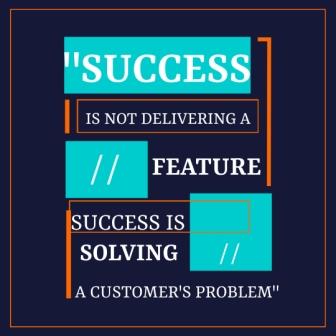
Want to Start Making Consistent Sales in Your Business?
Gain access to our FREE customer acquisition guide
Eric Ries is an American entrepreneur, author, and pioneer of the Lean Startup movement.
Born in 1978, Ries studied computer science at Yale University, where he became involved in several startup projects.
His early ventures included a role as a software engineer at There.com, a 3D social network that ultimately failed, which provided him with valuable lessons on startup failure.
In 2004, Ries co-founded IMVU, a social entertainment company that allowed users to create 3D avatars and interact in virtual spaces.
It was during his time at IMVU that Ries began developing the ideas that would later become the Lean Startup methodology.
The challenges he faced in product development and market testing at IMVU led him to rethink traditional approaches to entrepreneurship.
“The Lean Startup” was published in 2011 and quickly became a bestseller, widely regarded as one of the most influential business books of the decade.
The book formalized the principles of the Lean Startup, which include the concepts of validated learning, the Minimum Viable Product (MVP), and the Build-Measure-Learn feedback loop.
Ries has since become a sought-after speaker, advisor, and thought leader in the startup community.
He has worked with large companies and organizations, helping them apply Lean Startup principles to foster innovation and agility.
In addition to “The Lean Startup,” Ries is also the author of “The Startup Way” (2017), which explores how larger organizations can innovate and grow using Lean Startup principles.
- Title: The Lean Startup: How Today’s Entrepreneurs Use Continuous Innovation to Create Radically Successful Businesses
- Author: Eric Ries
- Publication Date: September 13, 2011
- Publisher: Crown Business
- Pages: 336
- ISBN: 978-0307887894
- Genre: Business, Entrepreneurship, Management
- Available in e-book, hard cover and audiobook versions
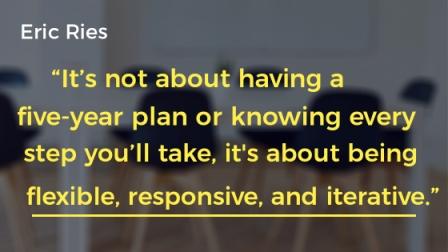
Test your Knowledge

Time's up
Read the full book
You may also like
Discover how to make your business successful from day one! No guessing games. Just the right ingredients to…
Tired of getting nothing but polite nods and empty compliments when you share your business idea? The Mom…
Got a brilliant business idea but unsure if it’ll fly? Testing Business Ideas is your ultimate cheat sheet…
What if you could build a wildly successful business without wasting time or money? The Lean Startup flips…
Want to know how to design products your customers will really love to buy? See our summary of…

